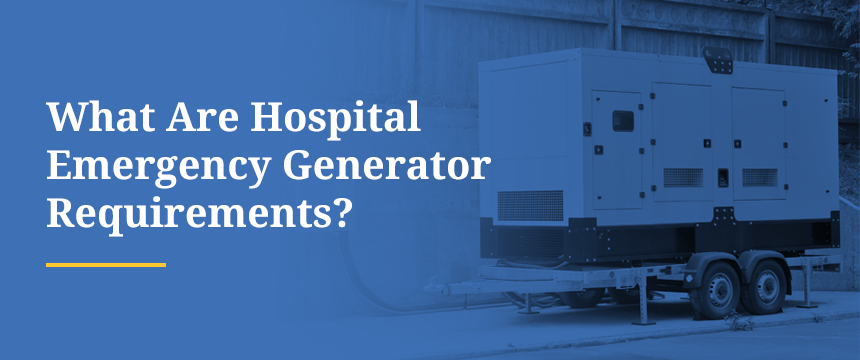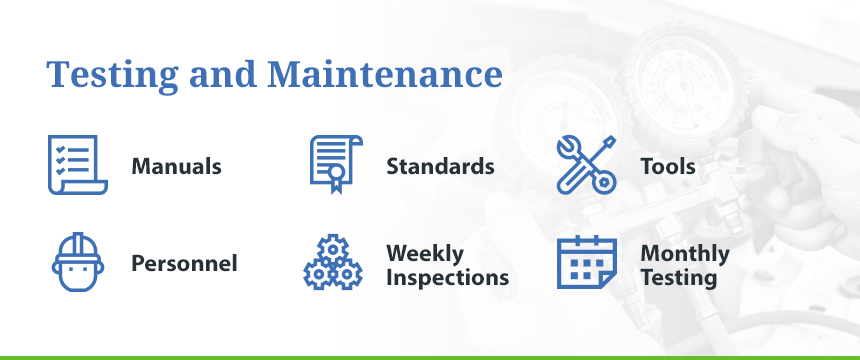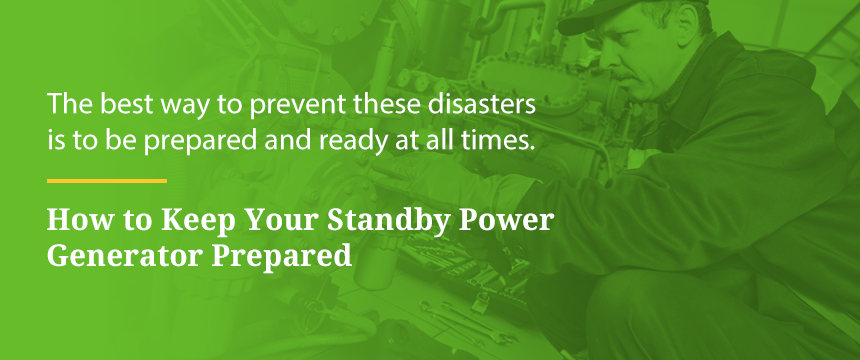

Hospitals use an immense amount of power. According to the 2003 Commercial Building Energy Consumption Survey (CBECS), hospitals accounted for less than 1% of all commercial buildings, yet consumed 4.3% of the total delivered energy used in the commercial sector. These survey results are not surprising. Hospitals are open 24/7. Thousands of patients, visitors and employees use hospitals every day. Within hospitals, staff use power to operate sophisticated medical equipment and lab technology. They also need electricity to prepare and store food, run a laundry facility on-site and heat or cool hospital buildings. In a hospital, many patients’ lives depend on electricity.
Enter your contact details, we’ll guide you to a cost-effective solution so you can get back to caring for your patients!

Click on a link below to jump down to that section within the content. Learn about hospital emergency generator requirements.
A hospital power outage can be catastrophic. Doctors, nurses and surgeons all need light to do their work accurately. Machines that are working day and night to keep patients alive need power to operate. Medical equipment needs to be sterilized before it can be used.Even just a few moments without power can be devastating in a hospital.
To prevent power outages, hospitals rely on emergency generators. Strict rules and regulations govern hospital emergency power requirements to make sure hospitals are always prepared. This guide covers hospital generator requirements and examines how these regulations help prevent disaster. We’ll also explore ways to make sure your generator will be ready to handle a power emergency.
Need fuel for your hospital generator? Shipley Energy makes it easy to prepare for outages, and we take pride in bringing our customers peace of mind. Learn more about our wholesale fueling solutions for the healthcare industry and contact us today.

If your medical care facility houses patients that rely on life-support systems, you need to comply with the National Fire Protection Association (NFPA) Life Safety Code, or NFPA 101. This code applies to hospitals, but also to other facilities such as nursing homes. It requires that emergency generators be installed and maintained in such facilities. To maintain generators, medical facilities are required to:
As a medical facility, your generator may fall into one of the following two standard categories. Either category is acceptable, but they have different regulations you need to follow.
NFPA 99 treats generators as part of the essential electrical system (EES). The EES refers to all electrical components designed to provide power during an outage and minimize additional disruption to the existing electrical system. There are different types of EES requirements, depending on the services provided by a facility and whether the facility uses life-support systems or not. For example, the NFPA 99 breaks down the EES into three different types – Type 1, Type 2 and Type 3. NFPA requires all hospitals with an EES to conform to Type 1 system requirements.
On the contrary, NFPA 110 treats generators as part of an emergency power supply system (EPSS). With this specification, there are two definitions you need to know:
The NFPA 110 breaks the EPSS into two categories – Level 1 and Level 2. Each level has its own set of standards. For example, Level 1 systems should be installed when equipment failure could lead to loss of human life or serious injuries. Level 2 systems should be installed where EPSS failure is less critical to human life.
Enter your contact details, we’ll guide you to a cost-effective solution so you can get back to caring for your patients!

Whether your generators and facility fall under NFPA 99 or NFPA 110, you’re still required to test and maintain your generators regularly. A few of the specific guidelines to keep in mind include:
When it comes to your hospital’s standby generators, one of the most critical standards is response time. Your generators need to start before too much damage has been done. According to current standards, hospital standby power must activate within ten seconds. Additionally, hospitals are required to store enough fuel on-site to keep generators running for a total of 96 hours, in case a power outage lasts for days.
As mentioned above, weekly inspections and monthly testing help ensure that your generators can meet these standards. If your generators fail any tests or inspections, they will need to be replaced or repaired.
One of the worst possible scenarios in a medical setting is if the emergency generator fails. It will also be unfortunate if the power does not return to its fullest extent. A hospital needs sufficient electricity to power all the different systems and machines.
Any delays in a hospital not only puts lives at risks, but they also result in lost time and money. Storm-related power outages cost the U.S. an estimated $20 to $55 billion a year.
Here are just a few of the serious consequences resulting from lost power in a medical facility.
In many hospitals, large numbers of patients rely on life-support machines to keep them alive. If these machines lose power, many patients could quickly lose their lives. Whether patients are in long-term critical condition or have recently suffered a severe injury, these machines are often the only thing keeping them alive.
In situations this dire, it is critical that the backup power turns on in that 10-second window. If the power is off for longer than that, it may be too late for some patients even if the power does return.
Imagine a patient was in the process of receiving an open-heart surgery when suddenly the power shut off. Surgeons need adequate lighting to perform these incredibly delicate operations. Without light, they cannot operate at all. However, with a quick-acting generator, it’s likely that the surgery can continue with minimal to no consequences.
Every medical task requires adequate lighting. Something as simple as filling out a form or applying a bandage becomes nearly impossible in the dark.
Communication is vital to a hospital’s operation. If a patient is alone and begins experiencing pain or complications, the staff needs to be alerted so that they can address the situation. Without power, some patients have no way to call for help when they need it.During a power delay, many things could go wrong and result in serious consequences for the patient.
Similarly, imagine an ambulance traveling with a patient to a hospital. In ordinary circumstances, the ambulance staff would be in constant communication with the hospital staff to prepare for the patient’s arrival. If staff members are unable to communicate due to a power outage, the patient might not receive the care they need.
A power outage decreases safety in any setting. Without light, people can’t see where they’re going or what they’re doing, and accidents are more likely to occur. In a hospital, where there are many ill patients, sharp medical devices and potential tripping hazards, even visitors are at risk during a power outage. Also, security systems may not function properly without power. If security systems fail, anyone could enter or leave the hospital.
Enter your contact details, we’ll guide you to a cost-effective solution so you can get back to caring for your patients!

No one can ever know when a power outage will occur. However, you can prevent a disaster by being prepared. Use the following tips to ensure your generator can handle the next big storm.
The formal standards are there for a reason. Officials have determined these standards are the best possible ways to keep your backup power reliable and dependable. While it’s even better to go above and beyond the required standards, you should meet these standards as a bare minimum.
Make sure your hospital emergency diesel generators can supply the necessary power to get your systems up and running again and that your system is capable of coming back in no more than 10 seconds.
As with any safety standard, you may be tempted to think a disaster will never happen to you and that you can wait to fix a problem. Resist these temptations. Safety standards are meant to keep everyone in your hospital safe and healthy. Today might be the day something will go wrong, and you need to be ready for it.
The regulations say that you need a backup generator. If you can add two generators– even better. This way, if one fails, the other will provide the necessary power. Having two generators is just one of the ways you and your facility can go above and beyond.
It’s impossible to know when something will go wrong with your generators. It’s important to check on them regularly and make sure none of the parts have corroded, rusted, broken or otherwise fallen into disrepair. An incident that might cause your generators to malfunction can happen at any time, which is why it’s crucial that you check on them regularly.
The good news is that many problems that could cause your generators to fail don’t happen overnight. By inspecting your generators on a weekly basis, you can catch a problem while it’s still an easy fix. For example, maybe you’ll see a part is beginning to wear down, or one section is corroding. You can then replace these parts before they cause any serious issues.
Inspections are a crucial part of being prepared, but they are only half the solution. The other half is testing. In addition to ensuring your generators look like they’re in good shape, you must also test them to make certain they’re working correctly.
It’s critical to train your staff on how to handle a power outage. Your employees need to know how to operate, inspect, test and maintain the generators. It’s up to you to get them the proper training they need. Hire professionals to train them, provide them with the resources they need, and help them stay up to date on new developments within the industry. You and your entire hospital can rest easy knowing that your generators are in the hands of well-trained professionals.
It isn’t enough to get the generators you need – you must place generators in the right location. For these alternate power sources to reach their maximum potential, there are certain locations you’ll want to avoid. For example, do not put generators on the rooftop or in the basement. Keep your generators safe and protected from extreme weather and disasters such as fires, floods, earthquakes and more. We recommend placing your generator above ground level in a secure, dry and insulated area.
Most importantly, you need the correct amount of fuel for your generator. You want the highest quality fuel and a large amount on hand to ensure your hospital has power for that full 96 hours. Lives are depending on your generators, and it’s imperative that when the time comes, they’re up to the task.
Reserve power and backup generators are not something you ever want to be unsure about. Lives depend on them. If you are wondering about the rules and regulations you should be following at your facility, don’t wait. Do some research today and determine what changes you need to be certain your patients receive the best care no matter what happens.
If you’re looking to improve your efficiency and take your emergency preparedness plans to the next level, Shipley Energy is ready to help. At Shipley Energy, we have the fuel you need to keep your generators running for days. We make it easy to prepare for an outage, and we take pride in bringing our customers peace of mind.
We offer wholesale fuel through a streamlined process so you can stock up with minimum hassle. We’re experts in the energy business, and we want to help your hospital or medical facility be ready for the unexpected. Not only do we make placing your wholesale fuel order simple and convenient, but we’re also unbeatable when it comes to customer service.
We serve Connecticut, Delaware, New Hampshire, New Jersey, New York, Maine, Maryland, Massachusetts, Pennsylvania and Rhode Island. If your hospital is located in these areas, then we want to help you get your generators up to the task. Contact us today to learn more about our wholesale fueling solutions for the healthcare industry.